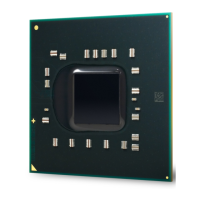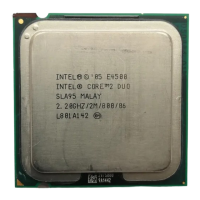LGA775 Socket Heatsink Loading
Thermal and Mechanical Design Guidelines 63
Appendix A LGA775 Socket Heatsink
Loading
A.1 LGA775 Socket Heatsink Considerations
Heatsink clip load is traditionally used for:
•
Mechanical performance in mechanical shock and vibration
⎯
Refer to Section 5.6 above for information on the structural design strategy
for the Intel ALCT Reference Design
•
Thermal interface performance
⎯
Required preload depends on TIM
⎯
Preload can be low for thermal grease
In addition to mechanical performance in shock and vibration and TIM performance,
LGA775 socket requires a minimum heatsink preload to protect against fatigue failure
of socket solder joints.
Solder ball tensile stress is originally created when, after inserting a processor into the
socket, the LGA775 socket load plate is actuated. In addition, solder joint shear
stress is caused by coefficient of thermal expansion (CTE) mismatch induced shear
loading. The solder joint compressive axial force (F
axial
) induced by the heatsink
preload helps to reduce the combined joint tensile and shear stress.
Overall, the heatsink required preload is the minimum preload needed to meet all of
the above requirements: Mechanical shock and vibration and TIM performance AND
LGA775 socket protection against fatigue failure.

